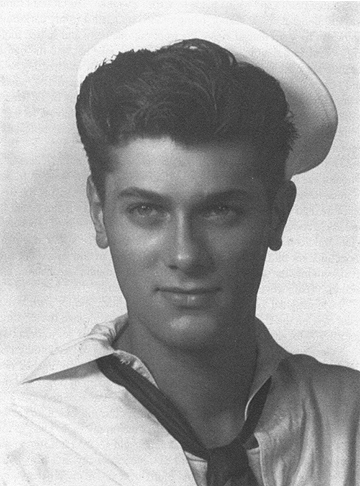
While Cary Grant was "playing" a Navy Sailor and appearing in movies like"Destination Tokyo" - this young man who would go on to become one of Hollywood's brightest stars -- was in the Navy - for real! In fact - he did wind upin Tokyo Bay - watching the surrender ceremonies aboard the Big Mo fromthe Signal Bridge of the USS Proteus.
There have long been "stories" about things aboard the Proteus.Some you just grin and wink - some you wonder about. Others - well... youknow. One story held that the Proteus had standing orders not to sail intothe "Bermuda Triangle" because supposedly a prior "Proteus" had sunk there- and -- well you get the idea - it was pure "sea story" - neither previousProteus sank - much less in the "Devil's Triangle" - and the idea the Navywould issue orders like that is just silly. But it was a commonly told"tale".Some background:Another Story that had been often told was that at one time a nowfamous movie star had once served active duty aboard as a young man --though by the time I got aboard (1971) - the name had been lost from the"tale". However - in the best tradition of "straight skinny" - it turnsout this tale is true. We've followed up on the story - and found thatthis "shipmate" has quite a story of his own to tell - not because of hiscurrent fame or stature (though that is amazing!); but because he was atender sailor in the fullest tradition of service - and at a time and placeforever part of the free-world's legacy.
With war rekindling patriotism, added to the near desperation ofdesire to escape such harsh conditions -- the US Navy offered a very attractiveway out. The Navy made much of it's romantic image of serving aboard aMan 'O War - being part of a proud fleet which sailed to exotic soundingports around the world. The Navy did have many advantages: a roof overa dry bunk vs. sleeping in some muddy fox hole. Chow was plentiful andhot. And of course there is that tradition and romance of two opposingMen 'O War skillfully maneuvering to deliver a fatal broadside into theenemy while protecting themselves at the same time. Of course reality wasa little less romantic - and a lot more dangerous. But to potential recruits- it was an attractive way out of a desperate existence.
So it was in 1943 when a young man living in East Manhattan decidedit was time for him to do his patriotic duty. He had always had an affinityfor the Navy - and a fascination with Submarines. He still tells storiesabout how, as a youth, he would build boats out of broom handles, a tincan fabricated into a crude propeller, with a rubber-band motor. He wouldtake his latest creation down to the park and go on patrol looking foran enemy to torpedo.
Being only 17, the Navy's rules against sending anyone under 18 intocombat caused him to be shuffled from school to school - keeping him busy.It was sometime during his training at the Signalman School that he lethis desire for duty in the Silent Service be known to the powers that be.In recalling that - he muses that it likely had something to do with seeingthe movie "Operation Tokyo Bay" and watching Cary Grant peer through theperiscope - that exciting notion had ignited this latest passion. Whateverthe cause - he soon found himself at Submarine School, New London, Connecticut.
 |
Guam had just been retaken from the Japanese - and was still a verydangerous place - as stragglers wandered out of the jungle for a long time- in fact the last supposed straggler came out of the Guamanian junglein 1974.
From here - we'll let Bernie Schwartz tell his own "TenderTale:"
I was assigned to the U.S.S. Proteus, a sub tender, as a memberof Submarine Relief Crew 202. Whenever a sub came in after a war patrol,they would tie up along side, and go on liberty. Our job as the "reliefcrew", was to go aboard and clean it up, scrape the barnacles from thesides, and assist in whatever repair and other work was needed. It washard work, sure, but it didn't matter. This was great for us, because the15 of us were all ready and waiting to be assigned to a submarine - andthis was great practice - plus we were making a real contribution in gettingthose submarines back ready for another war patrol.
It was during one of these cleaning routines when I got injured.We were cleaning the outside of the submarine, standing on scaffoldinglike the kind they use to clean windows in skyscrapers. As you finishedone level, you'd pull the ropes, and the scaffold would go up or down.But the sides of the submarine were bowed, so it was tricky We were onlykids and not too adept at lowering and rigging. At one point, the scaffoldingcame away from the side of the ship and slammed me on my back. I was inthe ship's infirmary for four days, but I was young and got over it.
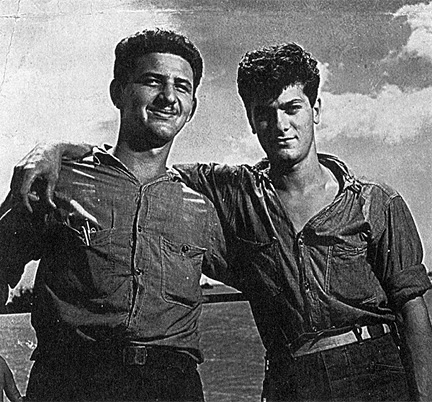 |
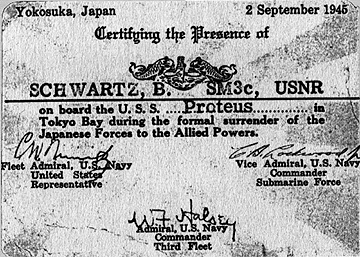 |
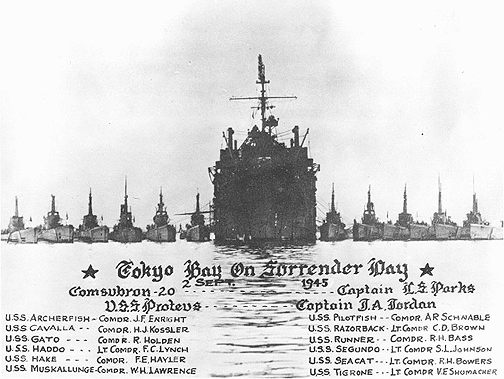 |
| Proteus on "Surrender Day", September 2, 1945 - with her "brood" of Submarines gathered on both sides. |
The end of the war also meant an end to any chance of me servingonboard a Submarine. I wanted to qualify for submarines so badly -- itwas the only thing I didn't get to do. I wish I could've done that. I didat least get to take a short trip on one - the USS Dragonet (SS-293) camein for refit in during June 1945 - and when they went out on a short shakedowncruise, I got to go. But I never would be able to look through that periscope- taking target bearings on an enemy ship.
But my "submarine career" wasn't quite over - yet! Fourteen yearslater - and I'd managed to get myself into a few movies here and there- and was making another one. What a site! I couldn't help staring at CaryGrant draped over the periscope yet again; taking bearings on an enemyship. It was amazing to me. I had watched Cary wrapped around the periscopein "Destination Tokyo" and wanted to be him. Only this time - instead ofbeing on the screen - I can reach out and touch him. What a wonderful thing.Absolutely amazing. Of course this time - instead of sinking a ship - hesinks a truck! If you've seen the movie "Operation Petticoat" - you knowthe scene I'm talking about.
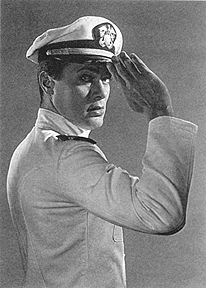 |
| The ever handsome Tony Curtis - here as Lt. Nick Holdenin the movie Operation Petticoat. He talks about himself watching CaryGrant wrapped around the periscope and wishing he was him - One has towonder if he has any idea of the number of younger men that watched himwrapped around a periscope - wishing the same - |
Whenever I am in Pearl Harbor, I rent a convertible and drive tothe submarine base with the top down. When I get to the gate, I tell theguard who I am and that I used to be in the Navy and could he let me onthe base. They always do. Then I drive up to an overlook and stare outat the submarine piers. It's still a wonderful relationship I have withthe Navy.
Tony Curtis -
SM3 USS Proteus (AS-19)
A few notes from the Webmaster:
The Proteus crew on Guam (including Mr. Curtis) between 16 February,1945 and 7 August, 1945 performed complete refit and voyage repairs to26 submarines additional with repair and support provided to numerousother units - including several surface craft.Submarine Squadron 20 - composed of 12 submarines, was commissionedon 1 March, 1944 - and assigned to the USS Proteus (AS-19) for the durationof the war. It should be noted that no Submarine from Squadron 20 nor anySubmarine that underwent a complete refit by Proteus was ever lost to theenemy. Seems Mr. Curtis and his shipmates did an excellent job!
Did that make much of a contribution to the war effort? Proteus'Squadron 20 Submarines fired some 350 torpedoes, scoring 132 hits - resultingin the sinking of 56 enemy ships - and the damaging of 9 others.
Mr. Curtis has been very kind with his time and memories - and all ofus here at TenderTale thank him for his time, kindness - and kick in thepants frankness. (If you'd like to explore that further - we would encourageyou to get and read Mr. Curtis' autobiography - it is hard to put down- and brutally frank!). As a personal note - I'd like to add it's beena delight to work with such a major celebrity - that still puts his bell-bottomson - one leg at a time! So to him I bid: "Fair winds and following seas,shipmate!"
Mr. Curtis' comments and images copyright © 1998Tony Curtis, Curtis Enterprises - used with Mr. Curtis' kind permission.No portion of his comments nor images may be copied or reproduced in anyform without the express written permission of Curtis Enterprises.
All other text, images and content of this page copyright© 1998 Common Cents Computers. No portion of this electronic documentnor images it contains may be copied or reproduced in any form withoutthe express written permission of Common Cents Computers.